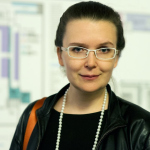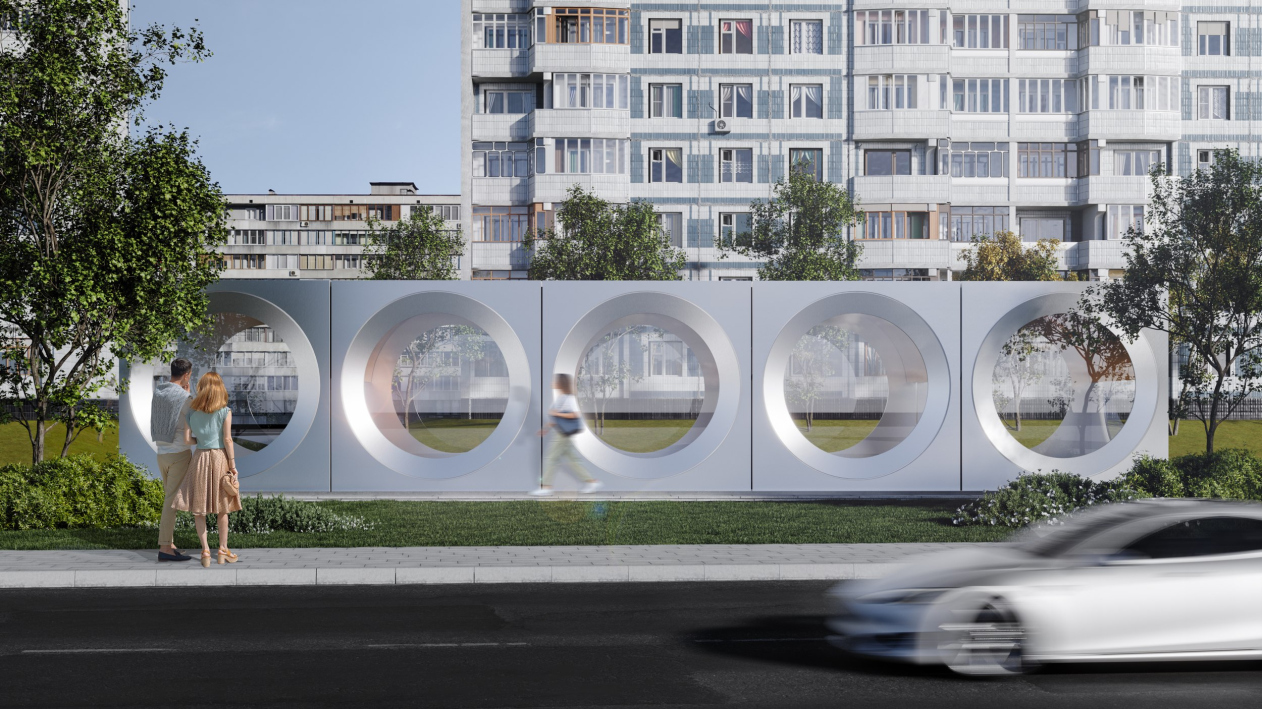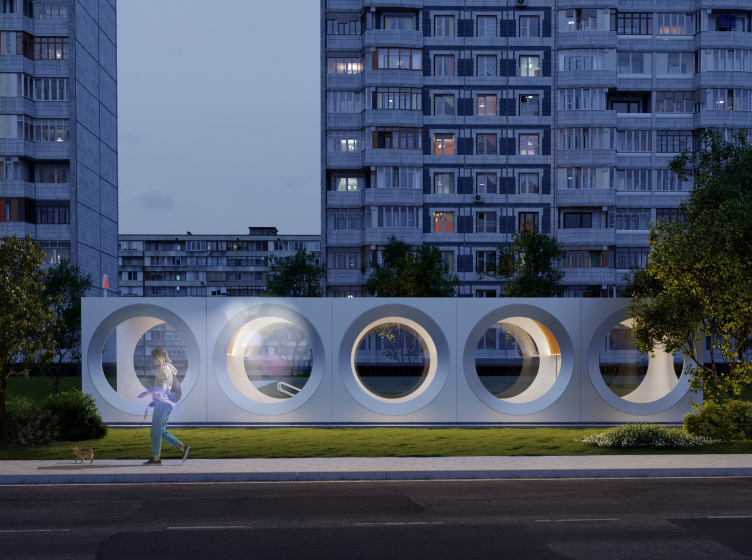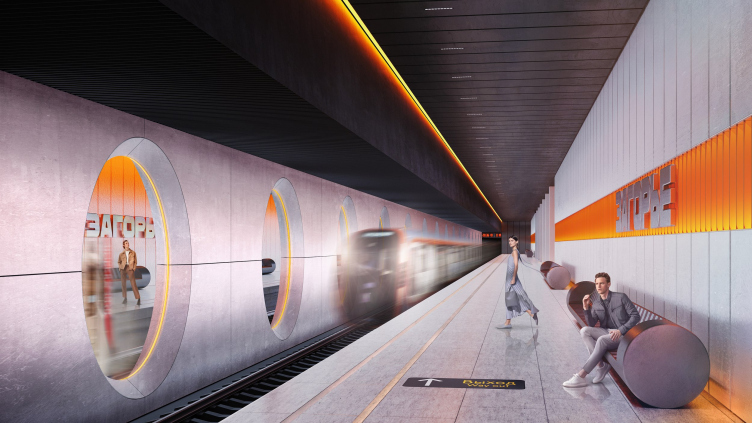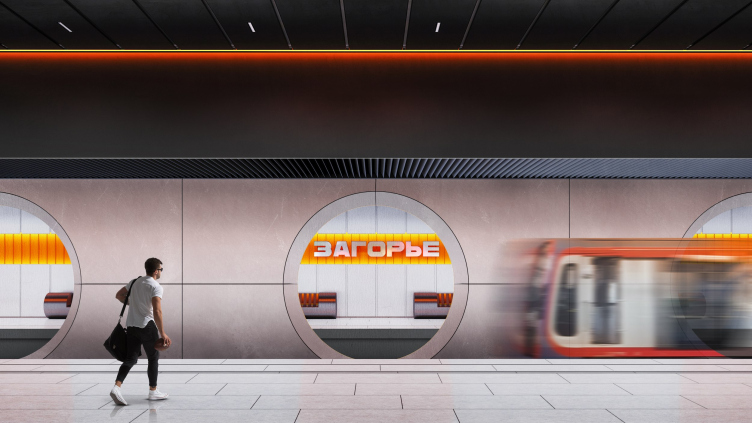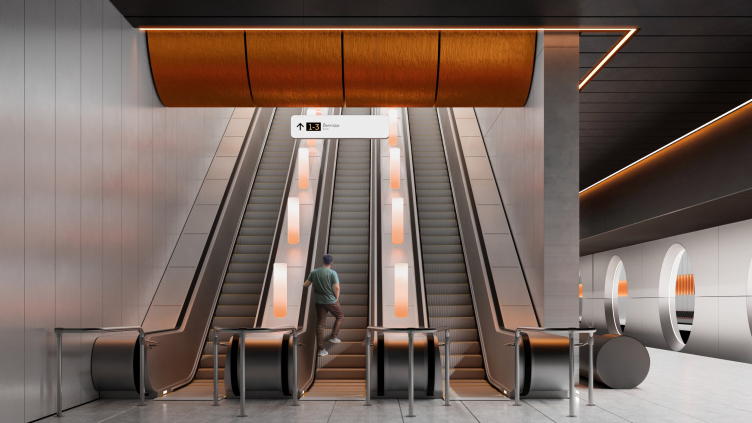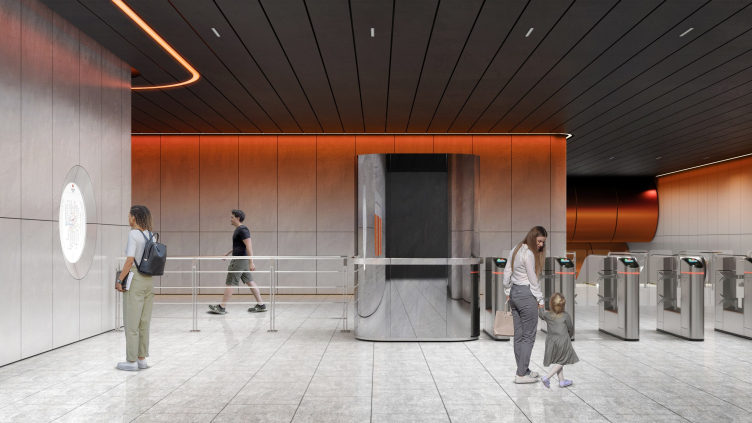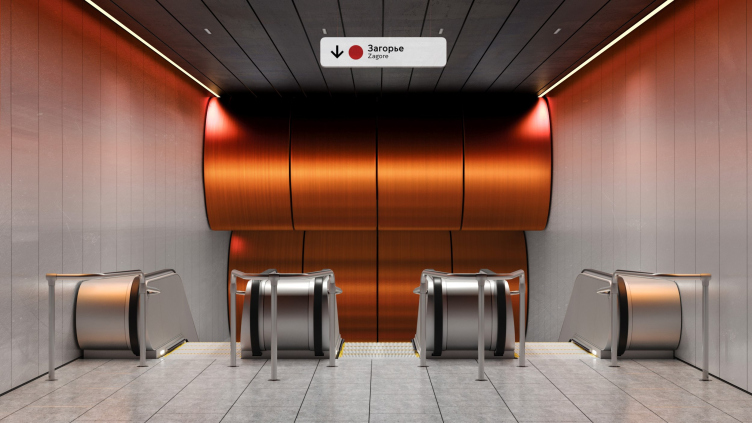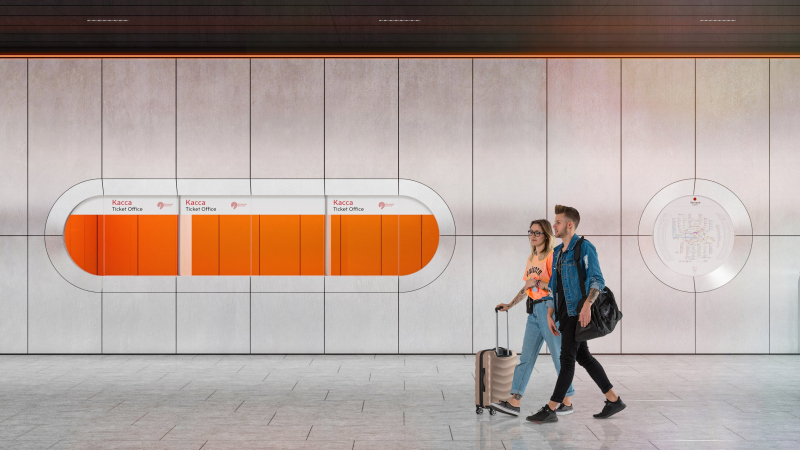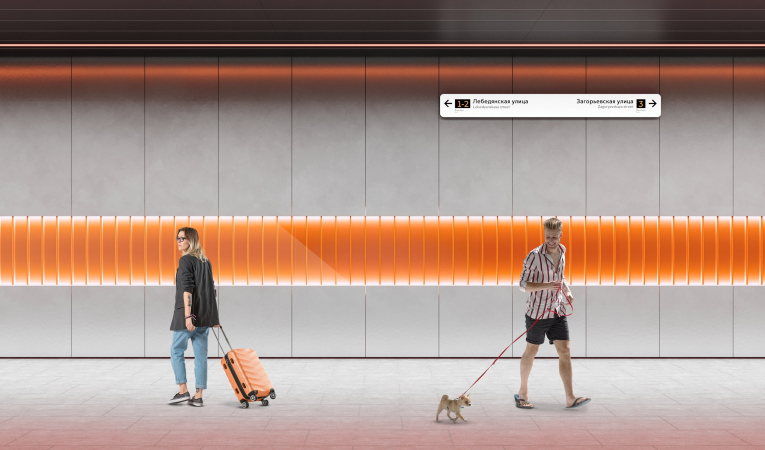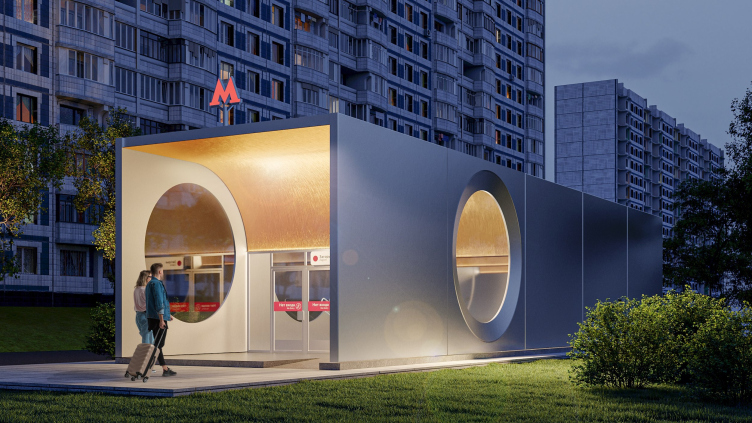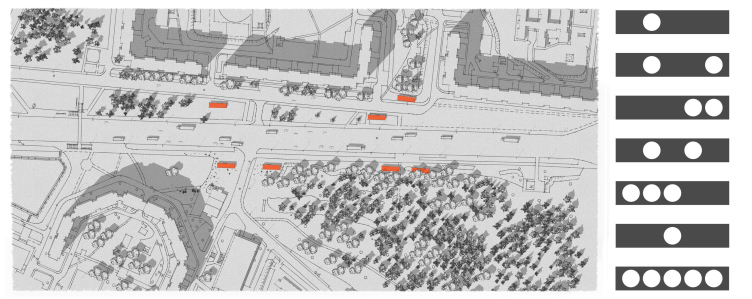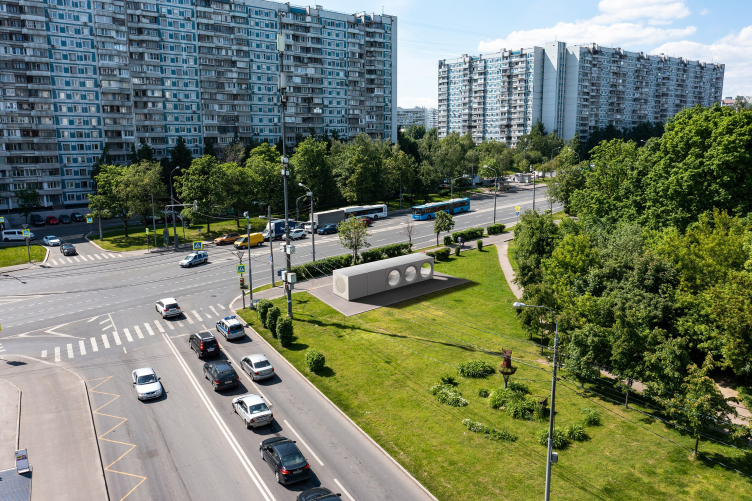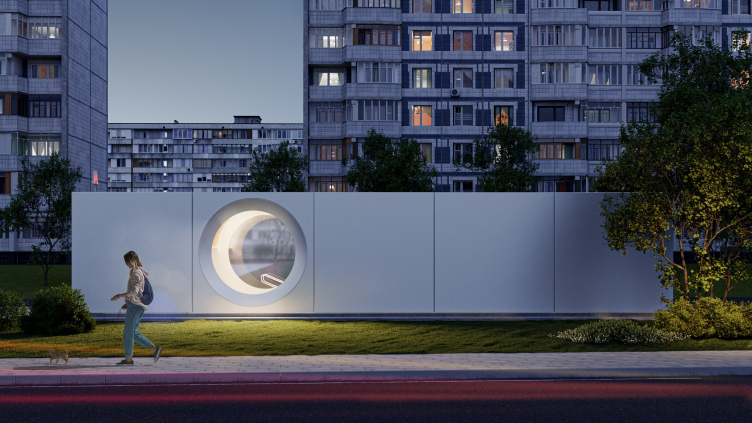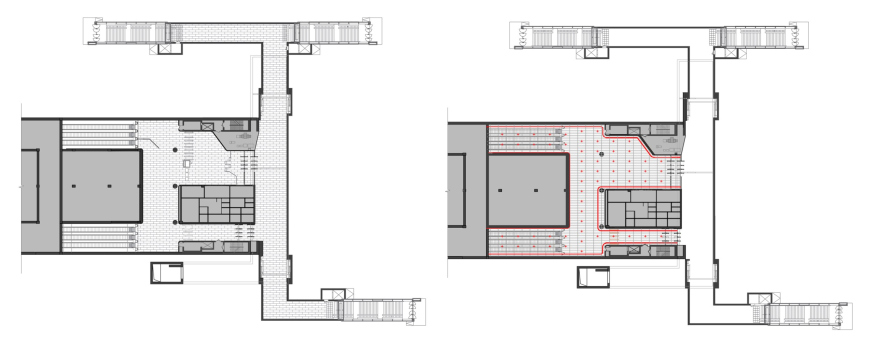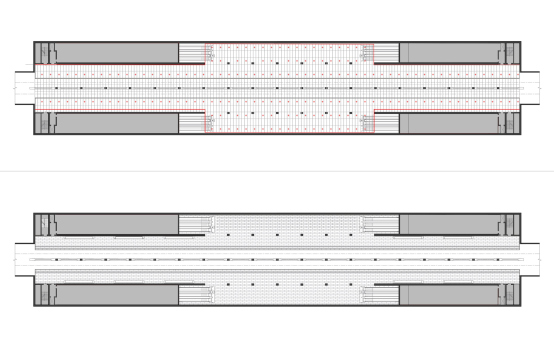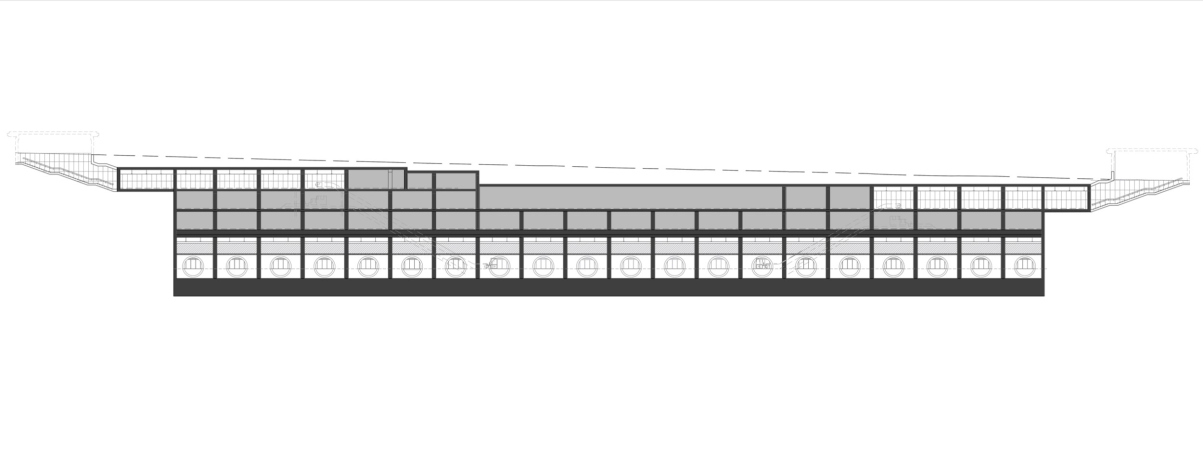“Zagorye” metro station. The competition project 2022
Copyright: © UNK
The Zagorye station is shallow, but still it is underground, with two vestibules on the sides of the tracks assembled in the central part. Such a type of platform is often seen, for example, in Paris and Rome but it is not quite habitual for Moscow – one of the examples could be the Arbatskaya station of the Fili line, but on the whole we are used to the central “island” platform with tracks running on either side and a sturdy wall with the name of the station behind the cars of the passing train.
Maybe this was the reason the authors of the winning project divided the space between the two tracks by a partition. It masks a row of supports between the trains, and it clearly divides the “spheres of influence” of these two platforms, to and from the center, visually and psychologically. The wall is not blind: it has large wide openings in them with elegant chamfers and circles of backlighting; through them, you can see the opposite platform, the trains, and large inscriptions of the station name on the walls – but it is thus “gaze through the frame” turns the space on the “other side” into a semblance of a picture on the wall. On the one hand, the perspective is open and we can gaze rather deep. On the other hand, “our” part of the platform is delineated in a quite definitive way – and, on the whole this probably provides a certain balance of comfort and openness: it is not too close, and not too open either.
“Zagorye” metro station. The competition project 2022
Copyright: © UNK
“Zagorye” metro station. The competition project 2022
Copyright: © UNK
According to the authors, they drew the main idea of the project from the name and the direction of the Lipetsksya Street: Lipetsk is a metallurgy city, and this is why the main theme became metal. Black ceiling, silver walls, orange inclusions and illumination hint at the color of the incandescent casting. The platforms are different in their shades of color: the one riding downtown is backlit with warm light; the one riding uptown is designed in cool tones. Interestingly, the difference is built in the illumination alone, meaning it is not too obvious. However, when you look from the “warm” platform to the “cold” one, then, thanks to the superposition of the “pictures”, the difference will be probably very well readable.
“Zagorye” metro station. The competition project 2022
Copyright: © UNK
The theme of hot metal is supported by the station's decor elements – there are few of them, which works for the expressiveness of each. Across the black ceiling, run orange linear lights that look like streaks of hot metal. The lamps on the escalators are colored from below by an orange gradient, as if they grew incandescent in front of your eyes. The same effect is provided by the reddish illumination on the ceiling’s contour. The massive seats on the platform are designed as cylindrical “slugs” of metal with brutal cutaways.
“Zagorye” metro station. The competition project 2022
Copyright: © UNK
“Zagorye” metro station. The competition project 2022
Copyright: © UNK
Meanwhile, you cannot say that emotionally the theme of incandescent metal, or the image of a blast furnace prevails – not in the least. Rather, its flames “accentuate” the austere and generally cool surface of the walls.
What becomes more important is the texture of the metal, or, rather, of metals. The main milky and silvery hue is sometimes complemented by polished mirror-like surfaces, most of them being copper: these are to be seen in the decorative ribbons on the walls and – particularly – above the escalators.
“Zagorye” metro station. The competition project 2022
Copyright: © UNK
The “copper” surfaces above the escalators are particularly beautiful. Everyone knows that when we ride an escalator we usually feel bored, and often examine the ceiling. Maybe this is the reason why in the new stations, particularly in those that feature author architecture, ceilings and escalators are given a lot of attention. Here, if you look upwards, you will see large traversal cylinders of copper color – they resemble either coils with copper wire or some sci-fi steam rollers. If you turn on your imagination, you may think that there is another escalator up above that gets “spun” on these cylinders. How often do we wonder about what is beneath the moving stairs and what actually makes them move? And here it looks as though we were given a hint. In a word, the industrial aesthetics of the ceiling is far from trivial.
In the entrance pavilions the bulgy “coils” turn into concave depressions of the same profile, this time golden. It looks as though some sort of underground reddish mold resurfaced here as a piece of jewelry designed not for the underground but for the city – because it is the entrance pavilions that make a statement about the presence of the metro station.
“Zagorye” metro station. The competition project 2022
Copyright: © UNK
There are seven overland pavilions, and all of them are subjugated to the common module of a circle within a square – this is how the architects emphasize the flexibility of the designed modular system, at the same time proposing to mark the differences between the volumes to better orient the passengers. There is a pavilion, all walls of which are composed of circular windows, and there are pavilions with two or three openings.
“Zagorye” metro station. The competition project 2022
Copyright: © UNK
Looking at the pavilions, you begin to realize that, of course, the main uniting motif of the entire project is not so much metal (although metal does play an important part) as a circle. Curiously, although the avant-garde architecture claims that it borrowed the circular window from steamers and airplanes and industrial chimneys, in actuality it has inherited the circular window from the gothic and renaissance architecture. But then again, it was avant-garde architects who proposed placing several circular windows in a row. Circles are all over the place here: at the station, in the entrance pavilions, and in the information graphics design, where they sometimes turn into ellipses. The combination of metal and large circular openings refer not so much to avant-garde as to the design search for the optimum “cosmic” shape of the sixties: bull’s eyes, circular hatches, and such like – what else do you need metallurgy for if not to help humans penetrate new and unfamiliar environments, be that outer space, or underground, or, more specifically, metro.
“Zagorye” metro station. The competition project 2022
Copyright: © UNK
Hence this simple and light form – as if from the sixties – modular and shining noble silver. Also, this is something that is relevant today, and something that rhymes with the industrial scenery of the Lipetskaya Street – at the same time without conflicting with the greenery of the Biryulevo Park on its opposite side.
“Zagorye” metro station. The competition project 2022
Copyright: © UNK
Such a “Pavilion Futura”, strictly speaking, can adapt to any kind of environment, sometimes thanks to its lightens and simplicity, and sometimes by contrast. By day, the silvery surface and the large diameter of the openings will work for easier perception of their construction, as if aluminum, as if brought here by accident and placed here and there. By night, however, they will glow from the inside, accentuating golden waves of the ceilings, yet not excluding the see-through gaze.
“Zagorye” metro station. The competition project 2022
Copyright: © UNK
“Zagorye” metro station. The competition project 2022
Copyright: © UNK
The design solution is light and austere, modular and diverse at the same time, clearly motivated by the location and filled with occasional, and because of that even more “tasty” details, as well as texture and color inclusions. Neither the reference to the avant-garde, nor the “spaceship” imagery, nor the “metallurgical” theme prevail and do not suppress – on the contrary, everything is simple and easy, optimistic, as in the sixties, which I recognize as an obvious strong side of the project.
